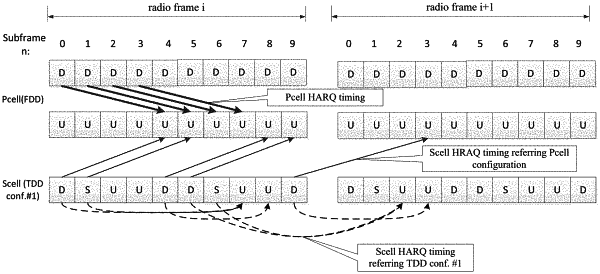| CPC H04L 1/1854 (2013.01) [H04L 5/14 (2013.01); H04W 72/23 (2023.01)] | 18 Claims |

|
1. A method performed by a user equipment (UE) in a communication system supporting Carrier Aggregation (CA) of a primary cell and at least one secondary cell, the method comprising:
receiving a downlink physical channel from a base station within subframes n−k for one of the at least one secondary cell, where variables n and k are natural numbers; and
transmitting in subframe n, to the base station, a Hybrid Automatic Repeat Request (HARQ) feedback corresponding to the downlink physical channel,
wherein, in a case where the primary cell is configured as Time Division Duplex (TDD) and the one of the at least one secondary cell is configured as Frequency Division Duplex (FDD),
if the UE is configured to monitor a control channel in another cell for scheduling the one of the at least one secondary cell, candidate values expressed in variable k include values as shown below:
if the primary cell is configured with Uplink (UL)-Downlink (DL) configuration 0:
5 for n=2; 5 or 4 for n=3; 5 for n=7; and 5 or 4 for n=8,
if the primary cell is configured with UL-DL configuration 1:
5 for n=3; and 5 for n=8,
if the primary cell is configured with UL-DL configuration 2:
5 for n=2; and 5 for n=7,
if the primary cell is configured with UL-DL configuration 3:
10, 9, or 8 for n=2,
if the primary cell is configured with UL-DL configuration 4:
10 or 9 for n=2,
if the primary cell is configured with UL-DL configuration 5:
10 for n=2, and
if the primary cell is configured with UL-DL configuration 6:
8 for n=2; 6 for n=3; 6 for n=4; and 6 or 5 for n=8.
|